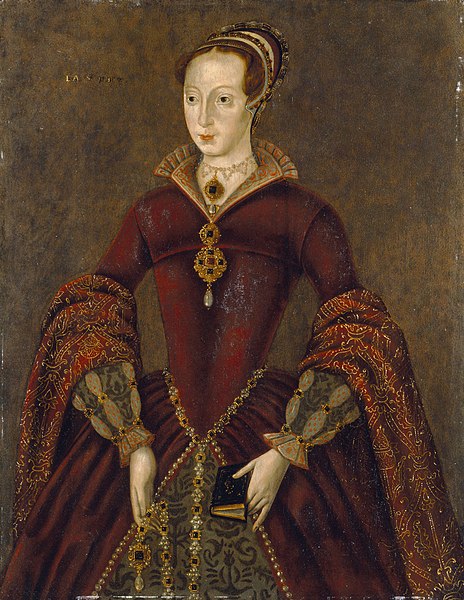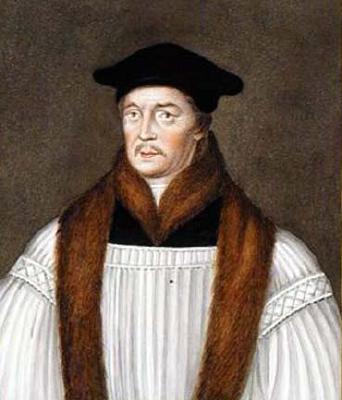 |
| Lady Jane Grey |
Desperate to
retain power the Duke of Northumberland persuaded the young Edward to nominate Lady Jane Grey as his successor. Jane was a great granddaughter of Henry VII and was married to Northumberland’s
son Guildford Dudley. Her accession to the throne was
announced on 10th July 1553.
Edward had
agreed that his Protestant cousin could be his successor, but had died before
the prepared act could be placed before parliament in September. A Protestant
successor, who stood waiting in the wings and had a much nearer claim on the
throne, the Princess Elizabeth was ignored.
Mary Tudor, Edward’s half-sister was at
Kenninghall Palace when she learned that Jane was to take the throne Mary
assumed was rightfully hers. On 14th July Northumberland rode with
an army to East Anglia, the new Queen having begged that her father stay with
her; Northumberland answered
‘Since ye think it good, I
and mine will go, not doubting of your fidelity to the Queen’s majesty, wh0m I
leave in your custody.’[i]
In his
absence the privy Council switched sides. On July 18th, following
the desertion of many senior officials and nobility a warrant for the arrest of
Northumberland was issued.
Mary Tudor
Mary moved
to Framlingham Castle with its better defences. Northumberland hoped that the
people of the lands he marched through would flock to his banner, but many
seemed to prefer to support Mary, the old king’s daughter and the young king’s
sister, rather than a remote cousin. The Protestant revolution was only just
over twenty years old. Many must have felt that having a Catholic monarch would
not be an issue.
Howards Resurgent
Mary rode up
to London accompanied by the Duchess of Norfolk[ii]. On 10th August Norfolk
was given back his Order of the Garter, having already been released from the
Tower. And as Earl Marshal, Norfolk now in his eightieth year, was responsible
for the preparations for Mary’s coronation. He was joined by his grandchildren.
Northumberland was executed on 22nd August, with his son and heir.
The Duchess
of Norfolk accompanied Mary’s litter in the procession from the Tower and
carried her train in the Abbey. At the Coronation banquet in Westminster Hall
the Duke was assisted in his ceremonial duties by his grandson and heir, the
young Thomas.
In a letter
to Mary Jane agreed that she should never have accepted the crown and had
thereby done wrong
‘Not only to myself but to a
good part of the realm……….it being known that the error imputed to me has not
altogether been caused by myself.’[iii]
Jane and her
husband were charged with treason; the two lambs were led to the slaughter.
They were tried by a special commission on 13th November and the
Duke of Norfolk was among the commissioners who convicted them, along with
Thomas Cranmer and two of Dudley’s brothers.
Thomas Wyatt the Younger
On 12th
February 1554 Lady Jane Dudley was executed. There had existed the possibility
that she would be saved but her fate was sealed by the Protestant rebellion of Thomas Wyatt the Younger[iv] in January; an uprising her father
the Duke of Suffolk had used to stir up the midlands
against Mary’s proposed marriage.
Simon Renard
It was the
ambassador from the Holy Roman Empire, Simon Renard, who helped seal Jane’s fate, persuading Mary that her reign
would be destabilised by Jane’s continued existence. He also tried and failed
to have the Princess Elizabeth executed too[v].
Mary’s
relationship with her subjects was not assisted by her reliance on Simon
Renard, whose principal job was to ensure that the marriage between Mary and
the Emperor’s son Philip II of Spain went ahead. Emperor Charles V planned to expand the Hapsburg
Empire to include England, to be ruled by Philip. The marriage produced no
children and Philip spent little time with his elderly wife, whom he did not
find attractive.
The Howards in Mary’s Reign
Stephen Gardiner
The Duke of
Norfolk now took his grandchildren’s education in hand; he did not approve of
the Protestant dogma that Foxe had been inculcating them with. Thomas joined
the household of Stephen Gardiner, Bishop of Winchester and Lord
Chancellor as a page. Thomas and Henry were then moved to study with John White[vi]. Thomas did stay in contact with
Foxe, who left for the continent and safety shortly thereafter[vii]. The boys’ mother
remarried and had little contact with them.
Thomas, as
Earl of Surrey, was one of seven gentlemen of the chamber of Philip of Spain.
He was present when Philip arrived in England and was in attendance at the
marriage in Winchester.
The New Duke
On 25th
August 1554 the third Duke of Norfolk died and his grandson and namesake Thomas
became the fourth Duke. He was to be a good landlord to his tenants, becoming
known to later generations as ‘the good duke;’ perhaps inspired by Ket’s
Rebellion. Not only did Thomas become Duke of Norfolk, he also inherited his
grandfather’s role of Earl Marshal[viii]. At some point in 1554
the citizens of Cambridge made Norfolk High Steward of the city[ix].
As Earl
Marshal, Norfolk was head of the College of Heralds and he decided to sort out the college which was
suffering from internal dispute. In 1555 he obtained a new charter of
incorporation from the queen and established the college in new surroundings at
Derby House. Norfolk also put in place reforms of the college and instituted
regular progresses of the provincial kings of Heraldry, Clarenceux and Norroy,
into the counties. Norfolk’s reforms were embodied in constitutions covering;
‘The ancient manner and
order of offices of arms.’[x]
Norfolk
insisted on the highest standards of scholarship and record keeping, at a time
when the records of monasteries had been taken to be used as scrap paper and
priceless documents littered the High in Oxford.
Norfolk was
now in a position where he could indulge a passion for precious objects.
Kenninghall had been ransacked when his grandfather had been sent to the Tower,
but much of what was taken had been recovered. Over the next few years Norfolk
was to enrich and update Kenninghall, which was the first house in England
recorded as having a room designated as a bathroom, hung with tapestries and
where there were
‘Twelve pieces of copper,
great and small, to bathe in.’[xi]
Encouraged
by the example of his uncle John de Vere[xii] Norfolk revived his grandfather’s
patronage in a dramatic company. In 1556 the Duke’s Company gave performances
in Norwich and by 1559 had become one of the four principal dramatic companies
in England.
Marriage
Mary FitzAlan, Duchess of Norfolk
In 1556
Thomas married Mary FitzAlan, heiress to the Arundel estates
after the death of her brother Henry. The wedding had been approved during his
grandfather’s lifetime; as one of her wards Thomas had to obtain the Queen’s
permission. Mary’s father the Earl of Arundel was Lord Steward of the royal
household.
A special
act of parliament was passed to allow Thomas sufficient monies to support his
new bride. As a minor under the terms of his grandfather’s will he had £249[xiii] per annum; when he
reached his majority he would have £2,489[xiv] a year.
Mary died
the following year, eight weeks after the birth of her son Philip[xv] on 28th June 1559. All
the heralds were present for the funeral.
‘With many banners and
banner rolls borne about her.’[xvi]
the
seventeen year old duchess was buried at St Clement Danes church in London in
great state. Not long before Philip’s birth Norfolk had accidentally killed one
of his manservant’s when a gun he was carrying discharged, killing Thomas
Baynes;
‘A man well liked by and in
good repute with him, sported with him in a friendly and joking manner.’[xvii]
Norfolk was
pardoned for manslaughter at an inquest held later the same day.
Norfolk’s
second choice of wife fell on a cousin of his, Margaret Audley an heiress. A papal dispensation was
required for the two to marry and an emissary was sent to Rome in the spring of
1558. The Vatican was dilatory and negotiations were still ongoing when on 17th
November 1558, Queen Mary’s poor tortured body gave up the fight and she died,
possibly from cancer of the uterus. She was to be succeeded by her half-sister
Elizabeth.
Bibliography
Walsingham –
Alan Haynes, Sutton Publishing 2004
The Boy King
– Diarmaid MacCullough, Palgrave 2001
Lady Jane
Grey – Alison Plowden, Sutton Publishing 2006
Mary Tudor –
HFM Prescott, Phoenix 2003
Elizabeth I
– Anne Somerset, Fontana 1992
Elizabeth –
David Starkey, Vintage Books 2001
Rivals in
Power – ed. David Starkey, Macmillan London Ltd 1990
A Tudor
Tragedy – Neville Williams, Barrie and Rockcliff 1964
[i]
Mary Tudor - Prescott
[ii]
She and her husband had long been at odds over his treatment of her and his
having a mistress living at Kenninghall
[iii]
Lady Jane Grey - Plowden
[iv]
The aged Duke of Norfolk was sent out against Wyatt’s men, but he was
outnumbered and had to seek refuge in Gravesend.
[v]
Mary was urged on a number of occasions to have her younger and once much-loved
sister executed and each time she resisted the temptation.
[vi]
Bishop of Lincoln
[vii]
Norfolk became Foxe’s patron
[viii]
Still headed by the current Duke of Norfolk as Earl Marshal
[ix]
To obtain a powerful patron. Norfolk was also made High Steward of King’s Lynn
and Yarmouth. Norfolk remained High Steward until 1569.
[x]
A Tudor Tragedy - Williams
[xi]
Ibid
[xii]
16th Earl of Oxford
[xiii]
As at 2010 worth £60,700.00
using the retail price index or £950,000.00 average earnings www.measuringworth.com
[xiv]
As at 2010 £607,000.00 using the retail price index or £9,500,000.00
using average earnings www.measuringworth.com
[xv]
Philip was to inherit his maternal grandfather’s title of Earl of Arundel in
1580 and was made a saint by the Catholic Church in 1970.
[xvi]
A Tudor Tragedy - Williams
[xvii]
Ibid





No comments:
Post a Comment
Note: only a member of this blog may post a comment.